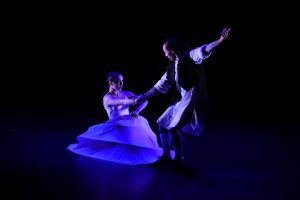PRIMA PARTE PASSA, SECONDA È MIGLIORE
Primo Passo explores life’s first steps through a compilation of dance features from choreographer Daniel Ezralow’s 30-year repertoire in a hit-and-miss retrospective that ranged from trite to enthralling. The seven pieces fit the theme of “new beginnings” well, showcasing movements that reflected an air of childlike curiosity or enthusiasm for a first-time experience. However, some of the pieces took away from the show, replacing romantic whimsy with childishness.
Premiering together for the first time as one full-length production, Primo Passo was presented at The Wallis on July 13 and 14. Ezralow’s evolution as a choreographer could be seen throughout the span of the evening, making the second half much more captivating. The most stunning performances in either half, the ones that truly captured his ability as a choreographer, were ones that did not include props.
The first segment, Brothers (1982), a collaboration with David Parsons, provided a strong start to the evening (photos above). Dressed in nothing but navy blue boxer shorts, Gerald Espinosa and Re’Sean Parsons conveyed the complicated ins and outs of male friendship, love and rivalry as they wrestled to Stravinsky’s Concertino for Twelve Instruments. Their mirrored movements and intense gazes with which they consistently followed each other around on stage conveyed a strong dependency. A realistic conclusion included them exiting on opposite sides at the very end, unable to reconcile their excess feelings, which men are typically taught to conceal.
In Foreign Tails (1985), however, the movements are almost dumbed down to a cartoon-like dullness as the dancers seemingly spent more time playing with their large hoop skirts than they did actually dancing. A promising beginning of optical illusions (something Ezralow is typically good at incorporating into his dance) showed two women (Kelsey Landers and Anthea Young)’”dressed in Victorian-esque, adjustable hoop skirts’”emerging from within bell-shaped, lit lamps that are raised high above the stage. Their two partners, footmen played by Junji Dezaki and Isaac Huerta, pushed Landers and Young around the stage as they squatted low in their skirt in a silly-cute beginning which had the potential for growth.
Co-created by Jamey Hampton, Ashley Roland and Morleigh Steinberg, the rest of the piece showed a lack of development, even as the choreography advanced through stages of the women learning to move on their own, then switching places with the men, whom they carried on their back. The long spans of repetitive movement and the characters’ expressions as they filtered through basic skips, tip-toeing on stage and leapfrogging hops as they took turns appearing on and off stage became grating. The initial spark of discovery the piece seemed to want to portray faded with every following moment that expanded the scene into unending child’s play and non-inventiveness made to seem cuter by being set to Claude Debussy’s compositions. The dancing does not do much to advance whatever plot there may have been.
A pleasant turnaround from Foreign Tails were the two following pieces that were commissioned by Hubbard Street Dance Chicago and came before and after the intermission respectively: SUPER STRAIGHT is coming down (1989) and SF (2004), both of which featured dark and light sides to upbeat and varying movement. Danced to Thom Willems’ music, SUPER STRAIGHT (photo above) concentrated on the dark side of the corporate world with static, rigid and rapid movements performed in unison by Espinosa, Landers, Will Clayton, Charissa Kroegeer, Vanessa Nichole, Raymond Ejiofor and Sasha Rivero, all dressed in business clothing. Espinosa’s performance stood out among the rest as he took the lead by breaking away from the uniformity and leaving the viewer wondering as to what may happen next through his encouraging other characters to break out of their homogenous roles and dance erratically separately or with each other.
The quick-paced steps continued in SF, which expanded the childlike concept of exploration in Foreign Tails into one with purpose. The 14 dancers’ response to the work was more dramatically vibrant and pleasant to watch, with the slight variations in footwork adding joy to their faces as the ensemble embraced some uniformity that non-restrictively allowed them to be flexible as they broke out on their own to Leonard Bernstein’s jazzy music.
The two crowning achievements of the evening came in the form of Awakening Solo (2005, pictured above) and Pulse (2000, pictured below), which took the theme of “first steps” and expanded it the most by stripping away complicated costumes and focusing on lighting (originally designed by Ryan O’Gara) and sound. Young’s silhouetted solo in blue light to Joachim Cooder’s live playing of the mbira and nail violin was mesmerizing. Her movements played like a birth, with each sway drawing the viewer deeper into her emerging form climbing through negative spotlight.
Pulse followed directly afterward and embraced more of that Ezralow repetition with Strauss’ Blue Danube setting a classical note to slides, waltzes and a calming embrace of glowing spotlight almost like an other-earthly presence each dancer paused to worship for inspiration before carrying on. The star they formed in center stage as they began to discover each other and touch hands as if to form a version of their own society and create life anew.
Ending the evening with Chroma (2013, pictured above), a play on color and fun TV screens and projectors, dragged down the beauty that was Awakening Solo and Pulse. Although expanding on inventiveness with a clever usage of multimedia, the direction in which this final piece moved the show was disconnected.
Overall, Primo Passo felt a bit disjointed in its assemblage. Some pieces bogged down the program, but the emotions evoked by Super Straight, Awakening Solo and Pulse were enough to display the choreographer’s talent.
photos by Dan Steinberg Photography for The Wallis
Ezralow Dance: Primo Passo
Wallis Annenberg Center for the Performing Arts
Bram Goldsmith Theater
9390 N. Santa Monica Blvd in Beverly Hills
played July 13 & 14, 2017
for more shows, call 310.746.4000 or visit The Wallis









